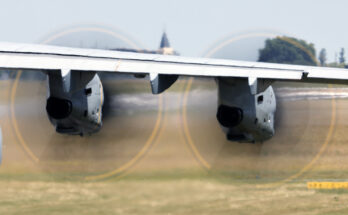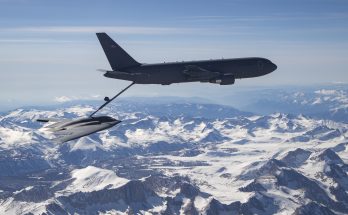On January 15, South Korea and the UAE signed two Memoranda of Understanding (MoU) to deepen bilateral defense ties.
The first called for continuation of efforts in joint investment and research and technological development that will further build on cooperation in the defense industry. The second involves the UAE – specifically the Emirates’ Tawazun Council – joining forces with South Korea’s KAI in developing the next generation of military multirole airlifters.
While the military transport aircraft initiative – based on KAI’s MC-X concept unveiled last year – has stolen the headlines, the real story is the continued spread of South Korea’s defense industrial reach.
The deepening of ties between the UAE and South Korea is just one of two notable instances popping up since the Russian invasion of Ukraine last February brought brittle global supply chains and defense production bottlenecks to the forefront.
The other came as a bit of a shock to defense observers, particularly as it concerned a NATO partner.
Seeking quality hardware at affordable prices – plus faster delivery timelines than the U.S. could provide, Poland last year turned to South Korea to fill orders for main battle tanks, self-propelled howitzers, multiple rocket launch systems (MLRS), and light combat aircraft.
That arms bundle enabled South Korean defense export orders to reach $15 billion in 2022, more than double the figure for 2021 ($7.2 billion).
South Korea🇰🇷 was the 8️⃣th largest arms exporter in 2017–21 with a 2.8% share of the global total. Its arms exports were 177% higher than in 2012–16.
New SIPRI data on trends in international #ArmsTransfers out now ➡️ https://t.co/qJHF1csayc pic.twitter.com/BQkh96aYrI
— SIPRI (@SIPRIorg) March 14, 2022
The scaling up of the country’s defense industrial sector and consequent growth as an arms exporter is the result of a long journey stretching back to the early 1970s, when the vicissitudes of U.S. foreign policy brought home to Seoul the vulnerability of being a sole-source militarily dependent nation. The buildup followed U.S. military withdrawal from Vietnam and the subsequent election pledge made by President Jimmy Carter to pull U.S. forces out of Seoul. Faced with its heavily armed neighbor to the north, South Korea required a greater degree of self-sufficiency in arms.
After years of investing in defense-related research and development initiatives, today South Korea’s defense industrial capabilities extend across the air, sea, land, and defense electronics spectrum. The nation produces basic and advanced jet trainers, light combat aircraft, submarines, frigates, destroyers, armored personnel carriers, infantry fighting vehicles, artillery systems, and advanced C4ISR and command & control systems. Domestic innovations have come in the form of light arms, unmanned systems, and some elements of fixed- and rotary-wing manufacturing.
South Korea has a major shipbuilding industry serving both commercial and naval markets that ranks as the world’s largest, ahead of China and Japan. The country’s naval maritime sector has churned out a wide variety of corvettes, patrol vessels, strike craft, and paramilitary boats for the South Korean Navy and the export market.
And in what may prove to be its largest leap, South Korea’s first domestically-produced fighter jet, the “4.5-generation” KF-21 Boramae, successfully flew at subsonic speed for the first time on January 17.
All this serves to make South Korea a palatable alternative on the global market for interested buyers. The success of the K9 Thunder 155mm self-propelled howitzer (SPH) from Hanwha Defense on international markets is indicative of the growing reach of South Korean exports. Purchasing countries include Australia, Egypt, Estonia, Finland, India, Norway, Poland, and Turkey.
While this budding export success did not come quickly or easily, it has indeed bloomed and increasingly become noticed. To aid in this process, the South Korean government is increasingly willing to accept the transfer of defense technologies to purchasing parties to ease sales – a key factor which contributed to Poland’s substantial bundled arms order.
Yet for its laudatory growth in defense industrial capacity, capability, and export success, South Korea remains dependent upon the United States for high-tech weapons.
Around 40 percent of the country’s arms purchases result from direct military imports, and its industry continues to rely upon foreign technologies and key subsystems. One example of this is the KF-21 Boramae itself, which includes a U.S. engine (General Electric’s F414-GE-400) to power the fighter, as well as U.S.- and European-derived missiles and precision-guided munitions, as well as help for Hanwha Systems from Israel Aerospace Systems subsidiary, Elta Systems, in developing the active electronically scanned array (AESA) radar system equipping the aircraft.
None of this is to say South Korea’s industrial growth and export success is about to stall, but to caution that the road remains winding, and that Seoul has proven a fortunate beneficiary of the Russia-Ukraine War.
While other European nations consider following in Poland’s wake and ordering K239 Chunmoo multiple launch rocket systems (MLRS) and K9 Thunder howitzers, should the war in Ukraine reach a conclusion soon, the sense of urgency surrounding such potential orders may recede into the background as politics intervenes and foreign policy considerations shift.
In the meantime, South Korea will need to continue lining up as many buyers and industrial partners as possible if it hopes to continue generating sufficient industrial know-how that will enable it to fully secure its own market and expand its catalogue of military products to compete with other top-tier supplier nations.
Dan Darling is Forecast International’s director of military and defense markets. In this role, Dan oversees a team of analysts tasked with covering everything from budgeting to weapons systems to defense electronics and military aerospace. Additionally, for over 17 years Dan has, at various times, authored the International Military Markets reports for Europe, Eurasia, the Middle East and the Asia-Pacific region.
Dan's work has been cited in Defense News, Real Clear Defense, Asian Military Review, Al Jazeera, and Financial Express, among others, and he has also contributed commentary to The Diplomat, The National Interest and World Politics Review. He has been quoted in Arabian Business, the Financial Times, Flight International, The New York Times, Bloomberg and National Defense Magazine.
In addition, Dan has made guest appearances on the online radio show Midrats and on The Media Line, as well as The Red Line Podcast, plus media appearances on France 24 and World Is One News (WION).




